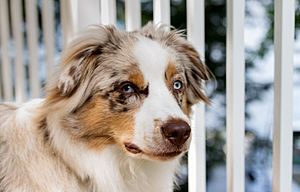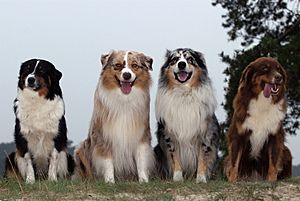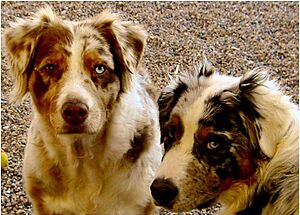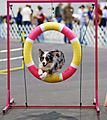Australian Shepherd facts for kids
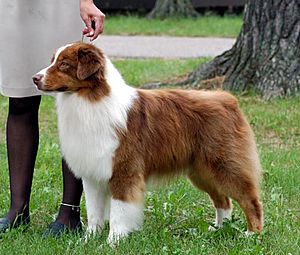
Red Australian Shepherd
|
|||||||||||||||||||||||||||||||||
| Origin | United States | ||||||||||||||||||||||||||||||||
|---|---|---|---|---|---|---|---|---|---|---|---|---|---|---|---|---|---|---|---|---|---|---|---|---|---|---|---|---|---|---|---|---|---|
|
|||||||||||||||||||||||||||||||||
| Domestic dog (Canis lupus familiaris) | |||||||||||||||||||||||||||||||||
The Australian Shepherd, often called the Aussie Shepherd, is a medium-sized dog breed. Even though its name suggests Australia, this dog was actually developed in the United States.
Aussies look a lot like English Shepherds and Border Collies. Studies show they are closely related. Like many herding dogs, Aussies are very energetic and love to work. They are great at jobs like search and rescue, helping after disasters, being therapy dogs, or even guide dogs. Because they are so good at these jobs, they have become the 17th most popular dog breed in the United States.
Contents
What Does an Australian Shepherd Look Like?
Australian Shepherds are known for their beautiful coats and unique eye colors. They are strong, active dogs.
Size and Weight
Australian Shepherds are medium-sized dogs. They usually weigh between 35 to 70 pounds (16 to 32 kg). They stand about 18 to 23 inches (46 to 58 cm) tall at the shoulder.
The Australian Shepherd Club of America (ASCA) says that female Aussies should be 18 to 22 inches (46 to 56 cm) tall. Male Aussies should be 19 to 23 inches (48 to 58 cm) tall.
Amazing Coat Colors
Aussies come in many different colors. The main colors are solid black, solid red (which looks like liver), blue merle, and red/liver merle.
These colors can also have copper (tan) spots or white markings. These markings can be on their face, chest, or legs.
- A black or red dog with copper and white is called a tricolor or tri.
- A black or red dog with only white (no copper) is called a bicolor or bi.
Too much white fur around their ears can mean a higher risk of deafness. Also, a lot of white on their face and ears can make them more likely to get sunburn.
The merle pattern is very common in Australian Shepherds. It looks like a mix of dark and light patches.
- Blue merle is a mix of gray and black.
- Red merle is a mix of cream and red/liver.
When two merle dogs are bred, there's a chance their puppies might get two copies of the merle gene. These puppies often have mostly white coats and blue eyes. They can sometimes be deaf, blind, or both. This happens because the two merle genes affect their color and can cause these health issues.
All black and blue merle Aussies have black noses, eye rims, and lips. All red and red merle Aussies have liver or brown noses, eye rims, and lips.
Unique Eye Colors
Aussies often have different colored eyes, which is called heterochromia. An old nickname for them was "ghost-eye dog."
Their eyes can be any shade of brown or blue. They might even have two different colored eyes. Sometimes, an eye can be "split," meaning it's half one color and half another. This looks a bit like their merle coat pattern.
Any eye color combination is fine as long as the eyes are healthy. Black Aussies usually have brown eyes. Red Aussies often have amber eyes, but they can also have blue eyes.
Tail Length
Some Australian Shepherds are born with naturally short or "bobbed" tails. Most are born with long tails. In the past, breeders often docked (shortened) the tails of puppies.
In the United States and Canada, the breed standard says an Aussie should have a natural bobtail or a docked tail that is no longer than four inches. However, in Europe, tail docking is banned in most countries. So, Aussies in Europe can have any natural tail length.
Images for kids
See also
 In Spanish: Pastor ovejero australiano para niños
In Spanish: Pastor ovejero australiano para niños


